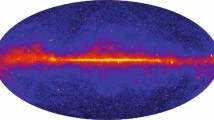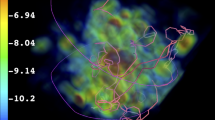Summary
In this paper we examine some consequences of the inverse Compton effect in the radio galaxies due to the presence of a universal black-body radiation at 3 °K. In particular it will be shown that the observed X-ray diffuse radiation between 1 keV-1 MeV may be interpreted as inverse Compton radiation from the strong and extended radio galaxies if this class of sources evolve withz and magnetic fields of a few µG are typically present. The Compton losses, and their relevance to the problem of the radio source spectra, are discussed. It will be shown that, if the average magnetic field is within the range (1 ÷ 3) µG, then the radio data point to an interpretation in which the expected breaks in the spectra occur at high frequencies. Then we estimate that the particles must escape from the systems in a time of at least ∼3·106 years. It is also pointed out that at high red-shift the Compton losses become so strong, as to drastically reduce the lifetime of the radio sources, so that important cosmological consequences may be expected.
Riassunto
In questo articolo vengono esaminate alcune conseguenze dell’interazione Compton inverso, nelle radio Galassie, dovuta alla presenza di una radiazione universale di corpo nero a 3 °K. Si dimostra, in particolare, che la radiazionex diffusa, osservata tra 1 keV e 1 MeV può essere interpretata in termini di radiazione Compton prodotta nelle radio Galassie forti ed estese, se tale classe di sorgenti evolve conz, e in esse sono presenti tipicamente campi magnetici di alcuni µG. Vengono inoltre discusse le perdite Compton in riferimento al problema dello spettro delle radio sorgenti. Si dimostra come, se i campi magnetici medi si mantengono nell’intervallo (1 ÷ 3) µG, sia possibile inferire dai dati radio che il l’interruzione nello spettro, previsto teoricamente, si trovi alle alte frequenze. Si stima quindi un tempo medio di fuga delle particelle dal sistema di 3 · 106 anni almeno. Viene infine rilevato come ai forti spostamenti verso il rosso la dissipazione Compton divenga così forte da ridurre drasticamente la vita media delle radio sorgenti, sicché importanti conseguenze cosmologiche possono derivarne.
Реэюме
В зтой статье мы исследуем некоторые следствия обратного зффекта Комптона в радио-галактиках, обусловленного наличием универсального иэлучения черного тела при 3 °К. В частности, будет покаэано, что наблюдаемое диффуэное иэлучение рентгеновских лучей между 1 кзВ и 1 МзВ можно интерпретировать как обратное комптоновское иэлучение от мошных и растянутых радио-галактик, если зтот класс источников раэвивается с z, и имеются магнитные поля в несколько цG. Обсуждаются комптоновские потери и их уместность в проблеме спектров радио источников. Будет покаэано, что если среднее магнитное поле расположено в области (1÷3)µG, то радио данные приводят к интерпретации, в которой ожидаемые нарущения спектров происходят при высоких частотах. Затем мы оцениваем, что частицы должны убегать иэ систем эа время, по крайней мере, ∼3·106 лет. Также отмечается, что при больщом красном сдвиге комптоновские потери становятся настолько интенсивными, что сушественно сокрашается время жиэни радио источников и что можно ожидать важных космологических последствий.
Similar content being viewed by others
References
A. A. Penzias andR. W. Wilson:Astrophys. Journ.,142, 419 (1965).
P. G. Roll andD. T. Wilkinson:Phys. Rev. Lett.,16, 405 (1965).
R. H. Dicke, P. S. E. Peebles, P. G. Roll andD. T. Wilkinson:Astrophys. Journ.,142, 414 (1965).
A. A. Penzias: Communication at theTexas Conference on Relativistic Astrophysics, New York, January, 1967.
R. R. Daniel andS. Z. Stephens:Phys. Rev. Lett.,15, 769 (1965);R. R. Daniel andS. Z. Stephens: preprint (1966).
F. Hoyle:Phys. Rev. Lett.,15, 131 (1965).
R. J. Gould:Phys. Rev. Lett.,15, 511 (1965).
J. E. Felten:Phys. Rev. Lett.,15, 1003 (1965).
J. E. Felten andP. Morrison:Astrophys. Journ.,146, 686 (1966).
V. L. Ginzburg andS. I. Syrovatskii:Origin of Cosmic Rays (Oxford, 1964).
E. T. Byram, T. A. Chubb andH. Friedman:Science,152, 66 (1966).
R. Giacconi: Communication at theTexas Conference on Relativistic Astrophysics, New York, January 1967.
R. Giacconi, H. Gursky, J. R. Water, B. Rossi, G. Clark, G. Garmire, M. Oda andM. Wada:Proceedings S.I.F. Course35 (New York, 1967), p. 73.
S. Hayakawa, M. Matsuoka andK. Yamashita:Proceedings of the International Conference on Cosmic Rays, vol.1 (London, 1965), p. 119.
A. E. Metzger, E. C. Anderson, M. A. Van Dilla andJ. R. Arnold:Nature,204, 766 (1964).
R. J. Gould andG. R. Burbidge:Astrophys. Journ.,138, 969 (1963).
M. Oda andM. Wada:Proc. S.I.F., Course35 (New York, 1965), p. 73.
M. Schmidt:Astrophys. Journ.,146, 7 (1966).
M. S. Longair:Mont. Not. Roy. Astr. Soc.,133, 421 (1966).
K. I. Kellermann:Astrophys. Journ.,146, 621 (1966).
R. J. Long, M. A. Smith, P. Stewart andP. J. S. Williams:Mont. Not. Roy. Astr. Soc.,134, 371 (1966).
N. S. Kardashev:Sov. Astr. AJ.,6, 317 (1962).
Author information
Authors and Affiliations
Rights and permissions
About this article
Cite this article
Bergamini, R., Londrillo, P. & Setti, G. The cosmic black-body radiation and the inverse compton effect in the radio galaxies: The X-ray background. Nuovo Cimento B (1965-1970) 52, 495–506 (1967). https://doi.org/10.1007/BF02711093
Received:
Published:
Issue Date:
DOI: https://doi.org/10.1007/BF02711093




